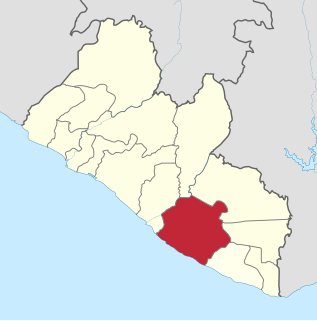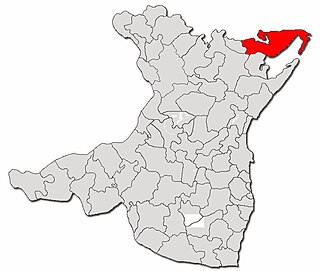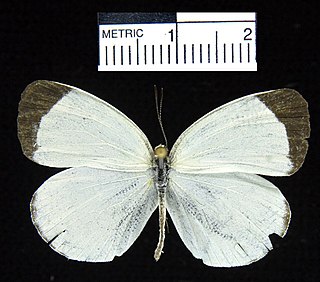| Sinoe | |
|---|---|
| Scientific classification | |
| Kingdom: | Animalia |
| Phylum: | Arthropoda |
| Class: | Insecta |
| Order: | Lepidoptera |
| Family: | Gelechiidae |
| Tribe: | Litini |
| Genus: | Sinoe Chambers, 1873 |
Sinoe is a genus of moth in the family Gelechiidae. [1]
| Sinoe | |
|---|---|
| Scientific classification | |
| Kingdom: | Animalia |
| Phylum: | Arthropoda |
| Class: | Insecta |
| Order: | Lepidoptera |
| Family: | Gelechiidae |
| Tribe: | Litini |
| Genus: | Sinoe Chambers, 1873 |
Sinoe is a genus of moth in the family Gelechiidae. [1]
Greenville is the capital of Sinoe County in southeastern Liberia and lies on a lagoon near the Sinoe River and the Atlantic Ocean. It is located about 150 miles southeast of Monrovia. As of the 2008 national census, the population stood at 16,434.
Sinoe may refer to:

Sinoe is one of Liberia's 15 counties and it has 17 districts. Greenville is the county's capital. As of the 2008 Census, it had a population of 104,932, making it one of the least populous counties in Liberia. Sinoe has the third-largest area of all Liberia's counties; it has the second least-dense population after Gbarpolu County. The County was originally a colony in the name Mississippi-in-Africa, under auspices of a chapter of the American Colonization Society as it was created with slaves from Mississippi to Liberia.

The Lecithoceridae, or long-horned moths, are a family of small moths described by Simon Le Marchand in 1947. Although lecithocerids are found throughout the world, the great majority are found in the Indomalayan realm and the southern part of the Palaearctic realm.

Mihai Viteazu is a commune in Constanța County, Northern Dobruja, Romania. It is situated in the northeastern part of the county, some 60 km (37 mi) from the county seat, Constanța. To the east are the shores of the Black Sea and of Lake Sinoe, while to the north is Tulcea County.

Sí Se Puede! is a 1977 various artists charity album featuring Los Lobos and various vocalists, including the Salas Brothers of the band Tierra. Proceeds from the album went towards the United Farm Workers of America. "Sí, se puede" is the motto of the United Farm Workers of America.
Gustavo Brambila is a Mexican-American winemaker in the Napa Valley.
Plahn Nyarn District is one of 16 districts of Sinoe County, Liberia. As of 2008, the population was 6,805.
The Sinoe oil field is an oil field located on the continental shelf of the Black Sea. It was discovered in 1991 and developed by Petrom. It began production in 1999 and produces oil. The total proven reserves of the Sinoe oil field are around 20 million barrels, and production is centered on 3,000 barrels per day (480 m3/d). The field also produces around 10.7 million cu ft (300 thousand m3) per day of gas and has reserves of 71 billion cu ft (2.0 billion m3).

Eurema albula, the ghost yellow, is a butterfly in the family Pieridae. It is found from southern Texas south through the West Indies and mainland tropical Central and South America to Brazil. The habitat consists of tropical forests and second growth.

Fernando Brambila, or Ferdinando Brambilla, was an Italian painter and engraver who spent most of his life in Spain, where he worked for the Royal Court. He is best known for his participation in the Malaspina Expedition.
Pecado de amor is a Mexican telenovela produced by Ernesto Alonso for Televisa in 1978.

Gelechiinae is a subfamily of moths in the family Gelechiidae. It was described by Henry Tibbats Stainton in 1854.
Sinoe capsana is a moth of the family Gelechiidae. It is found in North America, where it has been recorded from southern Florida.
Sinoe robiniella is a moth of the family Gelechiidae. It is found in North America, where it has been recorded from New York west to Indiana south to Mississippi and Arkansas.

Sinoe chambersi is a moth of the family Gelechiidae. It is found in North America, where it has been recorded from the United States and from Canada.
Sinoe kwakae is a moth of the family Gelechiidae. It is found in North America, where it has been recorded from Louisiana to Florida.

Antillocorini is a tribe of dirt-colored seed bugs in the family Rhyparochromidae. There are more than 30 genera and 110 described species in Antillocorini.

Steniini is a tribe of the species-rich subfamily Spilomelinae in the pyraloid moth family Crambidae. The tribe was erected by Achille Guenée in 1854.